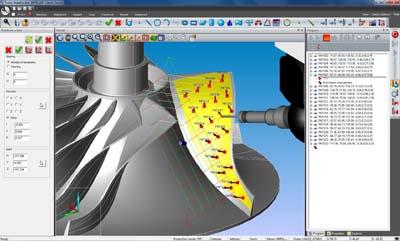
CAMIO7 from Nikon Metrology Inc. is a major software release in many ways. This multi-sensor CMM software now reflects the latest from Microsoft Windows, featuring the ribbon style toolbar. This serves as the central location where all software functions are logically grouped into tabbed sections, containing all required operations. This eliminates the need to search through long menu structures. For example, GD&T tolerances are located within the Inspect group so that feature output is always available.
CAMIO7 was developed with every user profile in mind. One important design criterion was to combine powerful functionalities with easy-to-use workflows. Users can select any combination of features to measure by using "teach and learn" from the handbox, picking from a CAD model, or typing coordinates from the component drawing. CAMIO7 automatically programs the touch points for each feature. However specific touch points can be defined if required.
When highlighting a group of multiple features, their properties are automatically filtered down to allow global modifications to all the remaining common properties from within this group in a single operation. There is no faster way to modify the nominal coordinates, measurement mode, fitting algorithms or add GD&T tolerances, etc.
Laser scanning with CAMIO7 is now easier to use for feature inspection. The new software interface allows both feature related measurement and reporting to be defined together. Such improvements reduce programming time drastically, especially for more complex parts that exhibit hundreds of features.
For measuring surface areas, CAMIO7 users can simply cover the target area with a configurable grid to automatically define the measurement points. Also, CAMIO7 includes full support for laser scan area definition, making it possible to use the scan data for reverse engineering or surface analysis. CAMIO7 offers true multi-sensor capability and simplified probe management to change between contact and non-contact probing within the same measurement program. In this way, the best CMM inspection routine for the application is achieved.
CAMIO7 planning provides the ability to open inspection plans either directly from CAD (Product Manufacturing Information) or a customer-specific format. The plan data can then be used to easily create a DMIS program including planned inspection routines and the application of GD&T tolerance data. In this regard, the software supports the latest versions of all popular CAD formats available
To support the off-line programming environment, the software provides full machine simulation and collision detection. CAMIO7 creates true DMIS output without translation, which also makes it the ideal stand-alone solution to create programs to run in compatible 3rd party DMIS software including PC-DMIS and Metrology.
CAMIO7 offers an integrated approach to the quality control process of CMM inspection. This true multi-sensor CMM metrology software supports traditional touch-trigger probes, continuous contact (or analog) scanning probes as well as the full range of Nikon Metrology laser probes. This way, CAMIO7 supports design and manufacturing teams to efficiently maintain control over production processes and to make informed decisions.
Contact Details
Related Glossary Terms
- computer-aided design ( CAD)
computer-aided design ( CAD)
Product-design functions performed with the help of computers and special software.
- metrology
metrology
Science of measurement; the principles on which precision machining, quality control and inspection are based. See precision machining, measurement.
- quality assurance ( quality control)
quality assurance ( quality control)
Terms denoting a formal program for monitoring product quality. The denotations are the same, but QC typically connotes a more traditional postmachining inspection system, while QA implies a more comprehensive approach, with emphasis on “total quality,” broad quality principles, statistical process control and other statistical methods.
- tolerance
tolerance
Minimum and maximum amount a workpiece dimension is allowed to vary from a set standard and still be acceptable.
